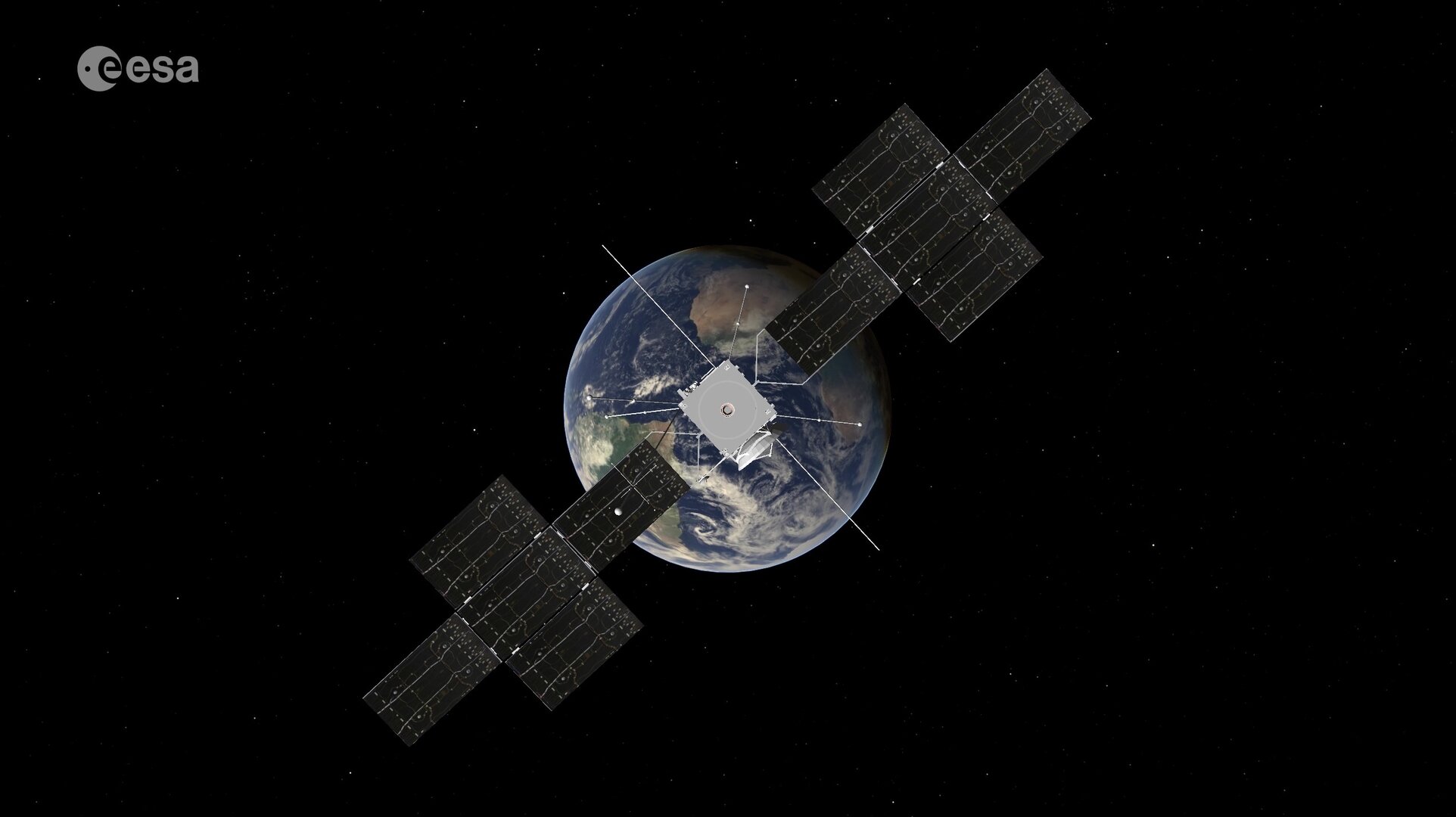JUICE Prepares for a first of its kind double-flyby next year.
A Jupiter-bound mission adjusted its course last week…for a rendezvous with Earth. The European Space Agency’s (ESA) Jupiter Icy moons Explorer (JUICE) fired its thrusters for 43 minutes on Friday, November 17th. This sets the mission up for a first of its kind double-flyby next year on August 23rd, as it passes the Moon and then the Earth to pick up momentum.
The mission is the European Agency’s first-ever mission to Jupiter. ESA has some experience with outer solar system exploration with the Huygens Titan explorer and lander, which hitched a ride to the Saturn system with NASA’s Cassini mission.
A Heavy Mover
Weighing in a 6,070 kilograms (spacecraft dry mass, plus fuel and payload adapter), JUICE is one of the heaviest ever planetary exploration missions mass-wise. The course correction was also a crucial test of the main engine in deep space. Now, engineers will assess if JUICE needs another smaller burn in May to tweak its trajectory prior to the Earth-Moon flyby.

“This manoeuvre used up roughly 363 kilograms of fuel—or almost exactly 10% of the 3,650 kilograms of fuel that JUICE launched with,” says Julia Schwartz (ESOC Mission Flight Dynamics Engineer) in a recent press release. “It was the first part of a two-part manoeuvre to put JUICE on the correct trajectory for next summer’s encounter with Earth and the Moon. This first burn did 95% of the work, changing JUICE’s velocity by almost 200 m/s.”
JUICE used a thruster burn in the past, to help free its stuck RIME (Radar for Icy Moons Exploration) antenna.

Why Flybys
Planetary flybys are a crucial and efficient way to get spacecraft to their destinations. Instead of carrying the mass of extra fuel, a mission can use the gravity of a massive world to simply gain momentum and sling it towards its target.
The August 2024 flyby comes 16 months after its April 14th, 2023 launch from the Guiana Space Center. Other missions including Cassini and Juno have used an Earth flyby to pickup speed in the past, but the added bonus of a close inbound lunar flyby is a first. Expect to see some great images from the spacecraft of the Earth-Moon pair, as researchers will likely take the opportunity to use the flyby to calibrate and test instruments aboard the spacecraft.
JUICE will first pass the Moon at just 750 kilometers distant, and will then pass the Earth 36 hours later. On Earth flyby, the mission will pass close enough (6,800 kilometers from the Earth’s surface, about a fifth of the distance to geosynchronous orbit) that well-placed observers using binoculars or a telescope may see the mission as a fast-moving ‘star’. This first-of-its-kind maneuver is known as a ‘LEGA’ or Lunar-Earth Gravitational Assist.

“The Lunar-Earth Gravity Assist (LEGA) was an outcome of the Mission Analysis design of the Interplanetary Transfer trajectory–they assessed the total delta-V cost–and it was found that LEGA resulted in the best option for about half of the April 2023 launch window,” Ignacio Tanco (JUICE Spacecraft Operations Manager) told Universe Today. “Curiously, had we launched on the later part of the launch window, then probably it would have been ‘cheaper’ in terms of delta-V to do a simple Earth Gravity Assist.”
The Timeline to Jove
Precise orbit determination analysis will start in January of next year. If this burn was accurate enough, it could put gravity in the driver’s seat. JUICE won’t need to use its engines again until it arrives at Jupiter in 2031. After 2024, JUICE will make a flyby past Venus in 2025, and then two more flybys past the Earth in 2026 and 2029.

Arrival at Jupiter and the Final Fate of JUICE
Then comes the biggest test of the spacecraft’s main engine. In 2031, just 13 hours after the spacecraft’s first pass near Ganymede and arrival in the Jovian system, JUICE will need to change velocity by a full one kilometer a second—five times bigger than this month’s change.
JUICE’s objective is to explore the icy moons of Jupiter: Europa, Ganymede and Callisto. These moons have only been briefly seen up close during the Voyagers, Cassini, Juno and New Horizons flybys. The enigmatic moons may harbor extensive subsurface oceans, and—just perhaps—chemistry conducive to life. JUICE carries a suite of instruments to probe the moons including the RIME radar sounder, the first ever such instrument to fly to Jupiter. RIME will be able to provide depth and thickness analysis for the ice and oceans of the Jovian moons.

Powering JUICE at Jupiter is also challenging, as the Sun is much fainter in the outer solar system. Like NASA’s Juno, JUICE is also solar-powered. The mission has two huge, folding cruciform-shaped solar panels. These will provide 50 watts of energy per square meter at Jupiter. Power efficiency at Jupiter’s distance from the Sun drops to just 3% of that received near the Earth.
“Flying with very large solar arrays–almost 100 square meters–with a main engine that will deliver a significant acceleration presents some very particular challenges,” says Tanco. “As an example, at Ganymede Orbit Insertion, when the tanks will be more depleted and thus a lighter spacecraft. In those conditions, the solar arrays interact heavily with the attitude control, which made it necessary to have special ‘shaping pulses’ of the Main Engine to control deflection of the array structure and prevent flapping.”
The mission will make 35 flybys past the three moons, before settling into its final orbit around Ganymede in late 2034. JUICE will be joined by NASA’s Europa Clipper Mission, launching late next year and arriving at Jupiter just before JUICE in 2030.
Watch for JUICE, briefly visiting our homeworld next summer.
Catch ESA’s JUICE documentary dropping on YouTube on November 23rd:

